Understanding Your Local Competitors and Formulating an Effective Strategy Before Entering the Chinese Market
- On October 29, 2025
- competing strategy china, competition analysis china
I. Introduction
- Report Purpose: This report aims to provide a systematic framework for Western enterprises to analyze local Chinese digital competitors and formulate an effective market entry and competitive strategy using digital marketing channels.
- Importance: The Chinese market is characterized by extreme competition. Understanding local rivals is essential for foreign companies to avoid blind entry and significantly enhance their probability of success. Unlike Western markets, competition in China is often described as “aggressive” or “fierce” due to the sheer volume of local Internet Firms (CIFs). CIFs must overcome tens of thousands of rivals, a concept often referred to as the ‘huge crowd strategy’ (人海战术), which gives them an implicit advantage over Western Internet Firms (WIFs).
- Target Audience: Western corporate decision-makers, marketing teams, and market entry strategists focused on digital expansion into China.
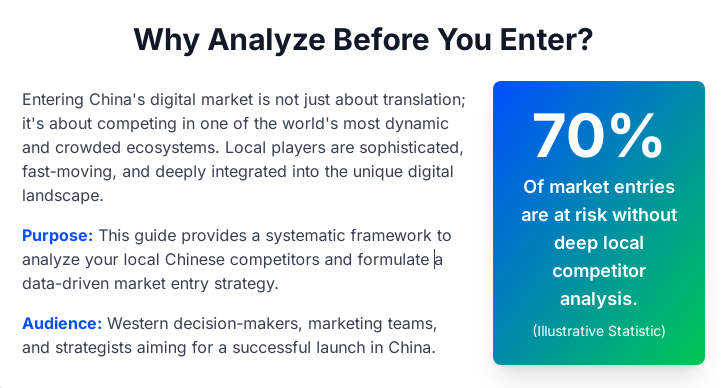
II. Identify Top SEO Competitors Using Core Business Keywords on Baidu
Success in China’s search environment requires shifting focus entirely from Google to Baidu, which holds over 60% market share. The initial step is identifying local competitors who dominate search visibility.
2.1 Core Keyword Identification
Identify core business keywords relevant to your industry, product names, or service categories. Use local tools like the Baidu Keyword Planner to expand and refine these keywords, considering the need for content to be written natively in Simplified Chinese to avoid penalties.
2.2 SEO Performance Analysis
Use Baidu search results and Baidu Index to assess the websites that rank highly for your core keywords. Crucially, Baidu’s algorithm differs significantly from Google’s:
- Technical Simplicity: Baidu’s crawler is limited and prefers clean, static HTML. Over-engineering a site with complex JavaScript can prevent it from being crawled correctly. Server-side rendering should be used for JavaScript-heavy sites.
- On-Page Signals: Baidu still relies heavily on literal on-page factors like keyword placement, meta keyword tags, and maintaining a suggested 2–4% keyword density in the body content.
- Backlinks: Baidu prioritizes backlinks from local Chinese websites, particularly those ending in .cn or .com.cn.
- Speed: Given that 99.7% of Chinese internet users access the web via mobile, page speed is critical. Utilize Baidu’s MIP (Mobile Instant Pages) tool and aim for a mobile load time under two seconds.
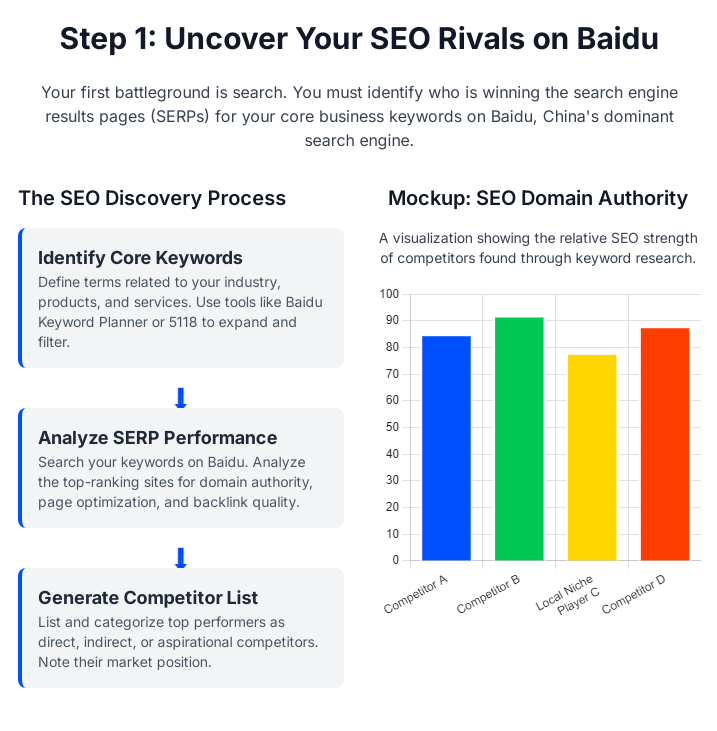
2.3 Competitor List Generation
Compile a list of local competitors with strong Baidu SEO performance. Classify them (e.g., direct, indirect) and briefly describe their core business focus and current market positioning.
III. Utilizing China’s Three Major AI Search Tools to Identify Direct Competitors
Leveraging the sophisticated knowledge bases of China’s leading Large Language Models (LLMs) can provide a competitive analysis layer that traditional search analysis may miss.
3.1 Brand Description Input
Prepare a concise brand description, including core products, target audience, and unique value proposition. Input this description into the three selected AI tools with a clear request for recommended direct competitors.
3.2 AI Search Tool Use
Engage with the three major domestic AI models:
- Tongyi Qianwen (Qwen, from Alibaba): Known for its massive, continuously updated dataset and strong real-time data integration, Qwen may provide fresher insights on trending product competitors and market dynamics. It also possesses strong multimodal capabilities.
- Wenxin Yiyan (ERNIE Bot, from Baidu): A knowledge-enhanced LLM, it is well-suited for general-purpose communication and understanding market context.
- DeepSeek: Excels in high-performance, complex reasoning, and technical/scientific problem-solving tasks, making it superior for analyzing competitors in niche or specialized B2B fields.
Record the recommendation results from each tool and analyze the underlying logic (e.g., based on semantic matching, academic data, or commerce trends).
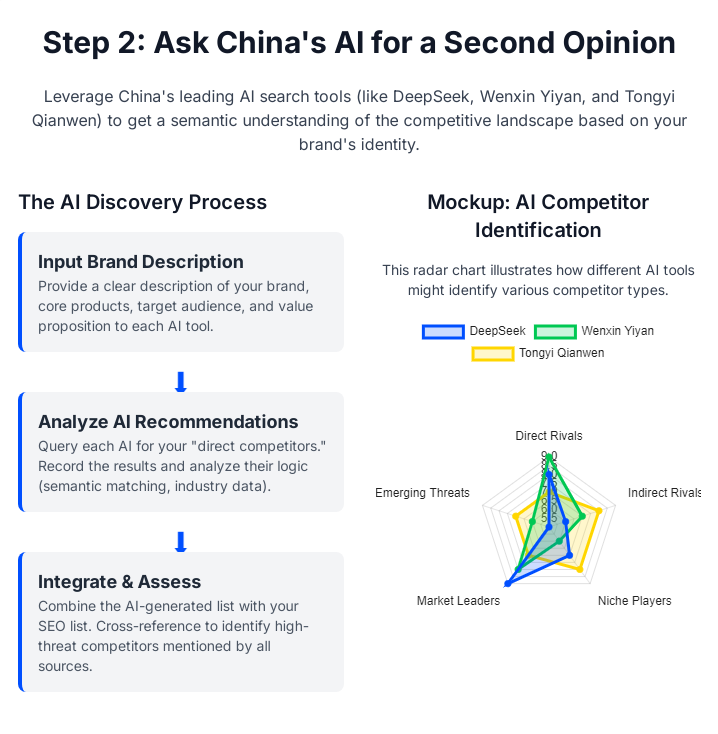
3.3 Competitive Integration
Integrate the AI-recommended competitors with the list generated from the Baidu SEO analysis. This forms a comprehensive competitor profile based on both technical search visibility and semantic market positioning. Evaluate the threat level posed by each rival.
IV. Analyze Competitor Website Copy for Unique Selling Propositions (USPs) and SEO Optimization
A close examination of competitor websites reveals how local firms market their advantages and achieve on-page SEO success.
4.1 Website Copy Analysis
Review key competitor pages (homepage, product pages, ‘About Us’) to extract their core messaging. Pay attention to how they describe their unique advantages, such as technological superiority, pricing models, or deep localization of services.
- Localization vs. Standardization: Chinese companies often excel at localization, adapting their messaging and identity to resonate with specific Chinese cultural references and needs. For B2B firms, successful copy often minimizes jargon and focuses on immediate functionality, such as clear CTAs and instant quotation systems.
4.2 SEO Optimization Assessment
Beyond the technical factors in Section II, assess how competitors use Baidu-specific features to gain a competitive edge:
- Baidu Ecosystem Advantage: Many local competitors leverage Baidu’s native platforms, such as Baijiahao, which is Baidu’s publishing platform. Publishing on Baijiahao offers faster visibility and can get content onto the first search results page even while a brand’s independent domain is still building authority.
- On-Page Elements: Check for proper use of H-tags, keyword placement, and high-quality Simplified Chinese content.
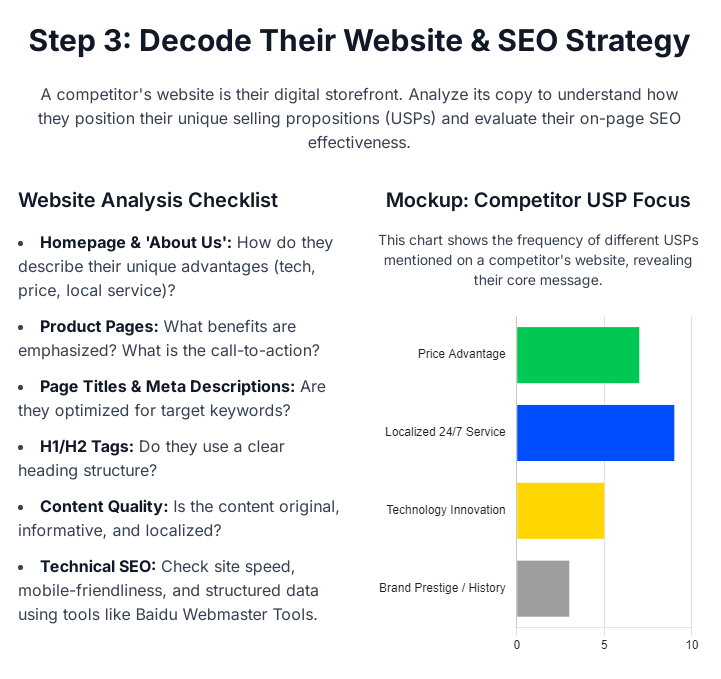
4.3 Summary Insights
Synthesize the competitors’ Unique Selling Propositions (USPs) and their SEO strengths/weaknesses. Identify successful copywriting strategies and SEO best practices that can be adapted for your brand’s localized strategy.
V. Observing Competitor Activity on WeChat, Xiaohongshu, and Douyin
China’s digital marketing requires a multi-platform strategy, as each social ecosystem serves a distinct function and audience.
| Platform | Primary Focus & Commerce Model | Key Content Strategy & Tempo | Critical Engagement Metrics |
| Douyin (TikTok) | Entertainment-first, Algorithm-driven discovery. Excels at impulse purchases, particularly for products under ¥200 (approx. $28). | Short video (15–60 seconds). High-frequency posting (3–5 times weekly). Must capture attention within the first 3 seconds. | High Daily Active Users (DAU) (700 million) and high time spent (89 minutes daily). High video view rates (6–7%+) are achievable. |
| Xiaohongshu (RED) | Community-driven, Search/Browse discovery. Dominates considered purchases, trust- and research-based influence. | Long-form content (images/videos), detailed reviews, educational content. Authenticity over polished commercial feel. Lower frequency (2–3 times weekly). | Strong penetration among affluent, urban women (70% female skew, 70%+ in Tier 1/2 cities). High Intent: 80% of searches are product/brand-related. Shopping guides can achieve high Click-Through Rates (CTRs) (30%). |
| WeChat (Ecosystem) | Peer-to-peer network, Relationship management (Social CRM). Focus on Private Traffic and retention. | Use Mini Programs for seamless, personalized experiences (shopping, booking, service). Content for retention and existing customer engagement. | Follower acquisition cost is high (Avg. 80–100 RMB per follow). Average CTR for official accounts is low (3–5%). Strategy focus should shift from acquisition to Customer Retention Management (CRM). |
5.1 Social Media Platform Coverage
Track competitors’ presence on the selected platforms, focusing on their official accounts and successful content.
5.2 Content and Metrics Analysis
Record content types (e.g., user stories, tutorials, promotions) and key performance indicators (KPIs) like post frequency, total views/PV, likes, comments, and shares.
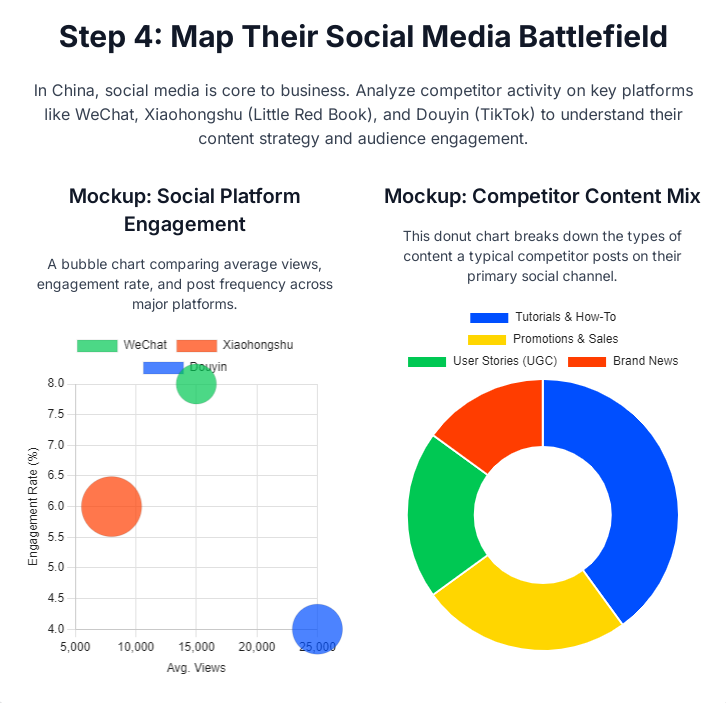
5.3 Engagement Insights
Analyze what drives high engagement. Successful content on Douyin often focuses on entertainment, while on Xiaohongshu, it emphasizes authenticity and detailed information. Use these insights to reverse-engineer their social media strategy and identify gaps.
VI. Formulating the Correct Competitive Strategy Based on Intelligence
The intelligence gathered on local competitors—their SEO tactics, AI profiles, USPs, and social media engagement—must directly inform your market entry strategy.
6.1 Highlighting Your Unique Selling Proposition (USP)
Chinese firms are renowned for their determination and strategic speed, often innovating through rapid experimentation and scaling up successful ideas quickly. To compete, you must clearly define a localized USP that resonates with Chinese consumers.
- Re-positioning: Re-evaluate or reinforce your brand’s unique offering (e.g., international background, niche technology, superior quality) based on the local competitive landscape.
- Localization: Ensure your brand story and messaging are culturally adapted to avoid being perceived as a foreign entity that lacks deep local understanding.
6.2 SEO Strategy
Your Baidu SEO strategy must be distinct from your Google strategy:
- Baidu Ecosystem Focus: Allocate resources toward utilizing Baidu-owned properties like Brand Zone ads for instant top-of-page visibility and publishing content on Baijiahao to build early domain trust.
- Technical Compliance: Prioritize simplicity, server-side rendering for complex elements, and optimizing for mobile speed using Baidu’s MIP.
6.3 Social Media Content Creation and Publishing
Design a targeted content calendar based on platform function:
- Douyin: High-velocity, entertaining short video content to drive impulse and awareness.
- Xiaohongshu: High-quality, authentic, detailed reviews and educational content to influence considered purchases among affluent audiences.
- WeChat: Focus on CRM and retention. Use Mini Programs to provide frictionless service and engage existing customers, offsetting the high cost of follower acquisition.
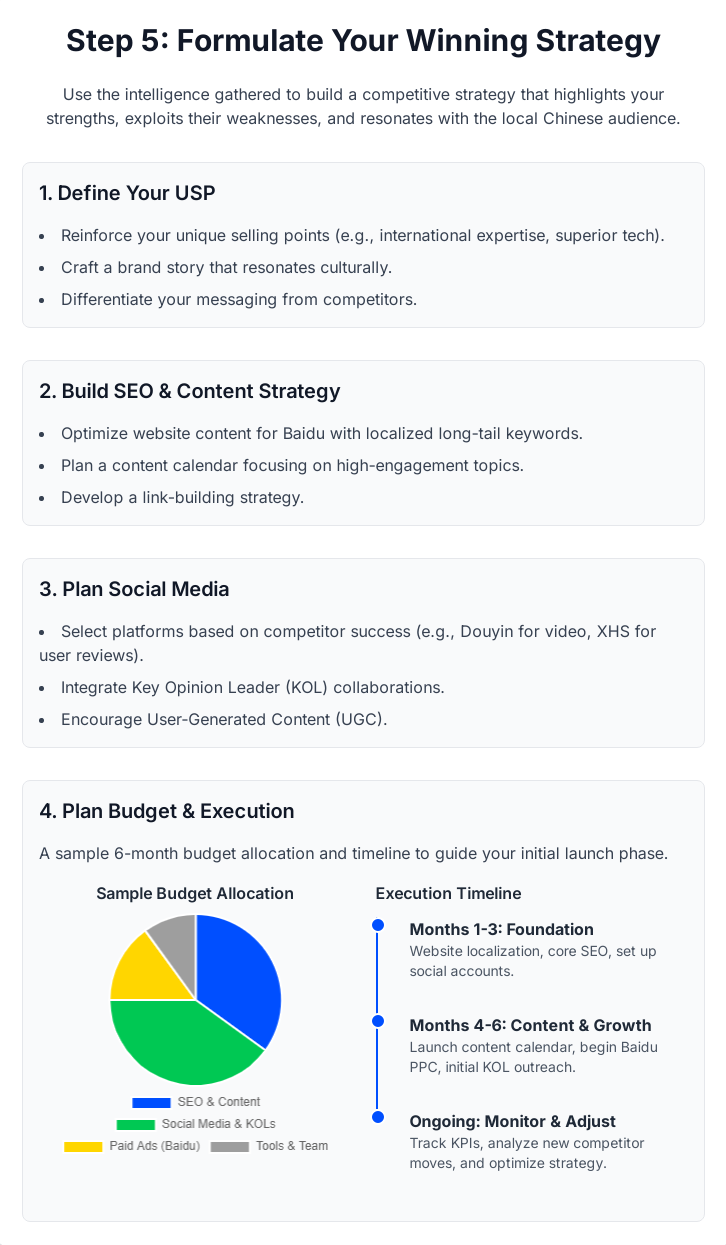
6.4 Budget and Execution Plan
Western companies often grossly underestimate the budget required for effective digital marketing in China, where costs are sometimes higher than in the US or Europe.
- Budget Allocation: Be prepared to allocate a significant budget. Competitive keywords may require 20–30% more budget than comparable keywords on Google. Top-tier Key Opinion Leaders (KOLs) can easily charge over $50,000 per post.
- KPIs and Monitoring: Do not apply Western KPIs, as the ROI is typically lower in China due to higher competition and costs. Set China-specific KPIs focused on platform engagement, conversion loop completion, and long-term customer retention (CRM) metrics, rather than just customer acquisition.
VII. Conclusion
The systematic failure of many Western firms in China’s digital space is often attributed not only to regulation but to a failure to grasp the hyper-competitive nature and strategic speed of local rivals.
Summary of Key Findings: Comprehensive competitor analysis is the foundation for an effective strategy. It reveals that success depends on technical compliance with Baidu, strategic platform-specific content for Douyin/Xiaohongshu, and a critical shift towards CRM and retention on WeChat.
Emphasis: Entering the Chinese digital market requires continuous monitoring and adaptation to its unique and fast-paced nature. Enterprises must adopt a localized, data-driven approach, utilize domestic tools (like the Chinese AI LLMs and Baidu platforms), and set realistic, China-specific Key Performance Indicators (KPIs) to mitigate risk and achieve sustainable growth.

 Unlock 2025's China Digital Marketing Mastery!
Unlock 2025's China Digital Marketing Mastery!